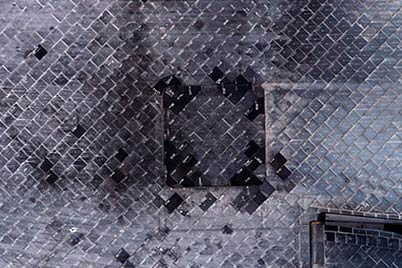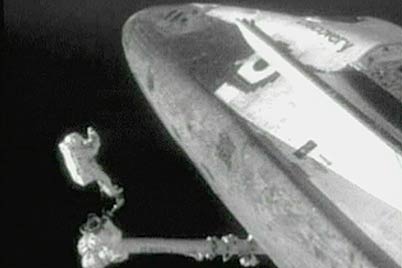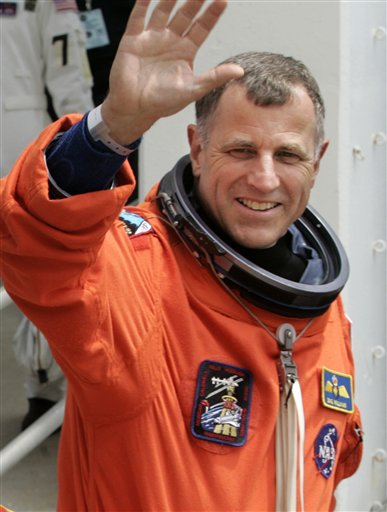Shuttle Crew Focusing on Heat Shield

The white gouge, bottom left, appears along with
scrapes against the
black tiles of the craft's belly. If NASA decides to
repair the gouge,
the work probably would be done in a spacewalk next Friday
The gouge - about 3 inches square - was spotted in zoom-in photography taken by the space station crew just before Endeavour docked there.The gouge is several feet from the starboard landing gear door. It appears to be the result of ice, but NASA said it could also have been damaged by foam insulation falling off the external fuel tank during liftoff Wednesday.NASA expects to determine on Sunday whether repairs are needed.

In 2005, astronaut Steve Robinson went outside
Discovery to make
repairs. It was the first time for such a venture.
Then teacher-turned-astronaut Barbara Morgan and crewmate Tracy Caldwell gingerly maneuvered the shuttle's robotic arm to scan the damage in the difficult-to-reach belly area. The laser will send three-dimensional images of the gash to engineers on the ground so they can determine how deep the gouge is and whether repairs are needed.
The space agency planned to spend several hours on the detailed inspection of the 3 1/2-by-2-inch gash. It was caused by a piece of foam that came off the shuttle's external fuel tank during liftoff last week, striking tiles that insulate the ship from the intense heat of re-entry to Earth, NASA said.
The space agency won't know how serious the ding is or whether astronauts need to repair the damage during a spacewalk until it's examined.
Adding repair tasks to a spacewalk is less likely now that managers know the gash was not caused by heavier and potentially more damaging ice like they initially suspected. They learned this after examining video from cameras retrieved from Endeavour's booster rockets, which were towed back from the Atlantic.
A grapefruit-sized piece of foam appears to have come off a bracket on the fuel tank, then bounced off a strut farther down and shot into Endeavour, said John Shannon, chairman of the mission management team. The brackets hold the long fuel feed line to the tank, and the struts connect the tank to the shuttle for launch. Ice tends to form near these brackets and cause the foam to pop off at liftoff.
Foam has come loose from the brackets on previous flights, Shannon said, and NASA is looking at how to redesign the apparatus to mitigate this problem.
"It's a little bit of a concern to us because this seems to be something that has happened frequently," Shannon said.
Directly beneath the damage is part of the aluminum framework of the starboard wing, which would provide additional protection during re-entry, Shannon said. He called that a lucky break.
Almost every mission in the 26 years of shuttle flight has ended with gouges of at least an inch in the thermal tiles that cover the belly. In one flight, nearly 300 dings that big were recorded.
The ship's belly is exposed to temperatures as high as 2,300 degrees Fahrenheit while passing through the Earth's atmosphere. Shuttle wings encounter even more heat, which is why the briefcase-sized foam that hit Columbia's left wing at liftoff was fatally damaging when left not repaired.
Since that disaster, NASA has equipped crews with tile repair kits. Depending on the extent of the damage, astronauts can slap on protective paint, screw on a shielding panel, or squirt in filler goo.
If Endeavour had to make an emergency landing right now, NASA still would take the chance based on all the risks, Shannon said.
The astronauts were woken up overnight by an alarm on a fuel cell that generates power for the shuttle. NASA said the alarm sounded because the fuel cell was able to cool down more than usual now that the shuttle is using a new system to draw power from the space station. Settings on the fuel cell's monitoring system were being changed to prevent the alarm from sounding again, officials said.
Astronauts completed the mission's first spacewalk on Saturday, installing a new addition to the orbiting outpost. At least two more spacewalks are planned.
Midway through the six-hour spacewalk, NASA's main command-and-control computer aboard the space station mysteriously shut down and a backup automatically kicked in. The problem was resolved on Sunday.
NASA hopes to keep Endeavour at the space station for at least seven days and quite possibly a record 10 days as a result of the new system for drawing power from the station. Mission managers are expected to approve the extra docked days on Sunday.
AP Aerospace Writer Marcia Dunn contributed to this report from Cape Canaveral, Fla.
8-16-07
SPACEWALK CUTU SHORT BY RIPPED GLOVE,
DECISION ON FIX DELAYED
The Associated Press
CAPE CANAVERAL, FLORIDA
An astronaut's ripped glove forced an early end to a spacewalk Wednesday as NASA put off a decision on whether to order risky spacewalk repairs for a gouge on shuttle Endeavour's belly.
After nearly a week of agonizing over the gouge, NASA indicated that it was close to wrapping up tests and would decide today whether repairs were needed.
Endeavour's commander, Scott Kelly, asked Mission Control which way managers were leaning. The reply: "Unfortunately, we have no idea which way the wind is blowing at the moment."
One of the astronauts who would attempt those repairs. Rick Mastracchio, had to cut his latest spacewalk short after he noticed a hole in his left glove.
The rip in the thumb penetrated only the two outer layers of the five-layer glove, and he was never in danger, Mission Control said. Nevertheless, he was ordered back inside early.
The unprecedented patching job on Endeavour, if approved, would be performed on the next pacewalk, now set for Saturday, a day later than planned to give engineers more time to analyze the situation. That could keep Endeavour and its crew of seven at the space station at least an extra day.
Preliminary results indicated no need for fixing the gouge, but mission managers were withholding jugement until the completion of heat-blasting tests on the ground.
The 3 1/2 inch long, 2 inch wide gouge - the result of a debris strike at liftoff - is in two of the thousands of black tiles that cover. Endeavour's belly and guard against the 2,000 plus degree temperatures of atmospheric re-entry. Part of the gouge, a narrow one-inch strip, cuts all the way through the tiles, exposing the thin felt fabric that serves as the final barrier to the ship's aluminum frame.
The exposed area and the gouge itself are so small that NASA is not worried about a Columbia-type catastrophe.
Rather, the concern is that if too much heat enters the crevice, the underlying aluminum structure might be damaged enough to warrant lengthy repairs.
